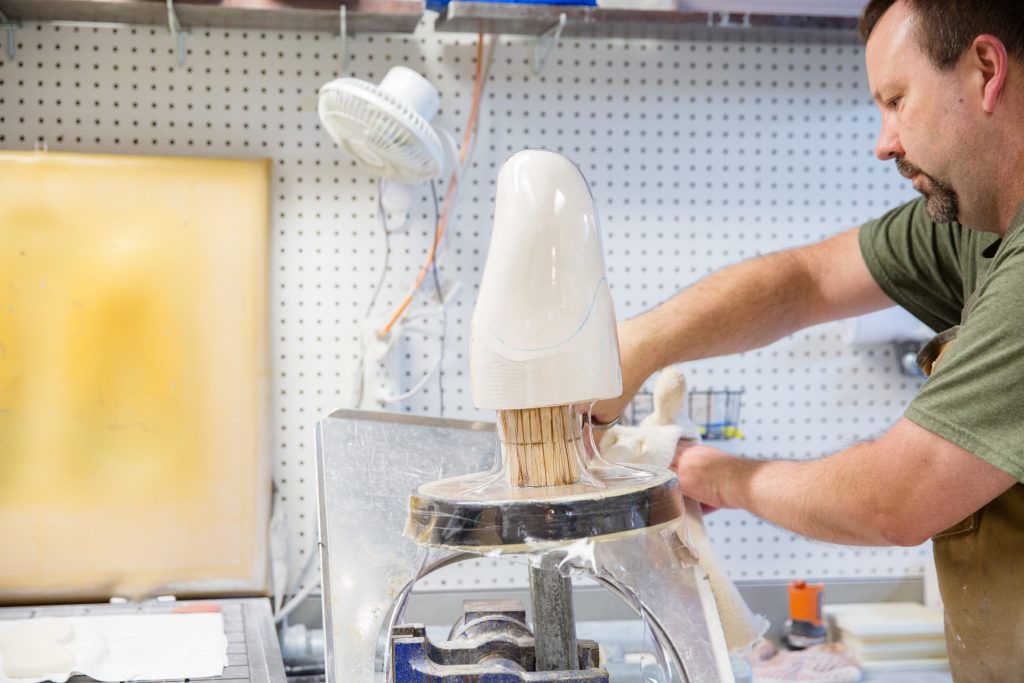
A custom prosthetic socket is arguably the most important part of the prosthetic system. It’s the crucial connection between your residual limb and your componentry. Not only do custom sockets protect your body, they also support your weight and assist you with controlling other components. Therefore, it’s important to take time to understand custom prosthetic sockets and how they work.
Horizon Orthotic & Prosthetic Experience has been providing high-quality custom prosthetic sockets to people in the Kansas City metro area, Sedalia, and Warsaw since 2007. Our patient-tailored process ensures that your prosthesis will keep you moving forward in life.

The two main factors to keep in mind when searching for a good custom prosthetic socket are (a) comfort and (b) a secure suspension. That simply means that your prosthetist should take great detail in customizing your socket to best suit your body.
A poorly designed socket can cause issues such as:
You’ll know if your custom prosthetic socket is up to par if you’ve had multiple fittings. Usually there will be a test socket before your definitive socket so that your prosthetist can understand what your needs are. This could be a quick process, or it may take a little longer depending on your body. It’s best to trust the process and know that your prosthetist is doing all he or she can to support you.
Total surface bearing sockets replaced older, less-efficient prosthetic technology like open end or patella tendon bearing sockets. Just as the name states, they contour and cover the entire surface of the residual limb. This allows the socket to have an even weight distribution.
In order for the prosthesis to remain firmly attached, the balance between your circulation and tightness of the socket have to be close to perfect.
Total surface bearing sockets are also paired with a liner, either gel, urethane or silicone, to limit friction and increase comfort and control. The liner helps to evenly distribute pressure throughout the limb, which lowers the overall pressure on the limb and improves comfort.
Direct suction sockets are typically reserved for above-knee prosthetics. These are flexible, highly contoured sockets where your residual limb is in direct contact with the inner socket. With direct suction sockets, you won’t need a liner since your limb will seal against the inside the socket.
One thing to keep in mind is that not all above-knee patients will benefit from direct suction sockets. People who are older, those who have a small residual limb, diabetic patients with limb volume fluctuations, new amputees, and people with skin conditions are probably better off with sockets that incorporate suction liners.
With direct suction sockets, the residual limb needs to remain in a constant volume state in order for the suction to hold. Your prosthetist is best to determine the most appropriate suspension method for your prosthesis.

Elevated vacuum sockets use a system that includes a cushion liner, a suspension sleeve to create a seal between the residual limb and prosthesis, and a pump to remove air. This suspension system can be used for both above-the-knee prosthetics and below-the-knee prosthetics. Pumps come in two different types: mechanical or electrical.
Electrical pumps maintain a desired socket pressure range. When the socket goes below a certain threshold, the pump activates to release air. As a result, a patient can take comfortable steps right away even if he or she has been sitting for a long period of time. These electrical pumps require charging every night in order to work properly the next day. On the other hand, mechanical pumps compress air with each step.
Although sockets using a mechanical pump may require a few steps after sitting to feel tight again, they won’t need to be charged like electrical pumps do. With elevated sockets, the residual limb needs to remain in a constant volume state in order for the suction to hold. Your prosthetist is best to determine the most appropriate suspension method for your prosthesis.
Double wall sockets are great options if you’re looking for increased comfort when you have a very short residual limb. Basically they are two sockets in one — an inner socket and outer socket. The shorter inner socket is, of course, shorter, and is tightly secured onto your limb and liner with the use of a suspension sleeve. Afterward, it is connected to the outer socket with a mechanical pin.
Since the two are separated, you can easily detach one from the other if necessary. With this design, knee joints and a thigh cuff can be attached to the outer socket to provide maximum knee stability for the short residual limb. This is like attaching a knee brace to a prosthesis.
You’ll never have to worry about ill-fitting custom prosthetic sockets with Horizon Orthotic & Prosthetic Experience in Kansas City. We are an award-winning, local prosthetic and orthotic company that strives to give our patients HOPE every day. Our highly trained clinical staff can evaluate you and custom design the best prosthesis to fit your limb, life, and goals. For your convenience, we have six locations spanning across the Kansas City and other Missouri areas.
For more information about custom prosthetic sockets in Kansas City, contact us today.